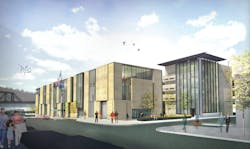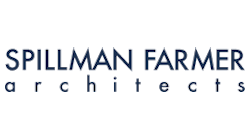PA: City of Easton and Spillman Farmer Architects Break Ground for First Phase of $31M City Hall and Transportation Center
Spillman Farmer Architects (SFA) and the city of Easton broke ground for the new, three-story, 138,800-square-foot transportation center garage.
The structure is the first phase of a two-phase, Easton City Hall and Transportation Center public development project located in downtown Easton, an Eastern Pennsylvania town of 27,000. The garage will support the second phase of the project, which will include the city of Easton’s new City Hall building, retail facilities, and a public transportation center. Spillman Farmer designed the $31-million, 183,800-square-foot mixed-use complex.
The entire complex is a part of the city of Easton’s economic revitalization program. “This garage is the latest in the series of urban development projects that are making our city safer, more beautiful, and more successful. We are looking forward to the economic opportunities a new City Hall complex will bring to Easton,” Easton Mayor Salvatore Panto, Jr. said. “We are also excited to have Spillman Farmer on board, as they have designed many successful urban development projects in Easton, such as the Sigal Museum and the Lafayette College Arts Plaza.”
Spillman Farmer Design Principal Joseph N. Biondo, AIA explained that the success of the project’s design is a result of integrated planning efforts by the design and consultant team, the City of Easton, the Easton Planning Department, the Redevelopment Authority of Easton, the Historic District Commission of Easton, The Lehigh and Northampton Transportation Authority (LANta), and Trans-Bridge Lines. “The Lehigh Valley has unique opportunities for historical value and new growth to exist side by side, providing the kind of infrastructure, built environment, and social context that will continue to draw people to our area. These challenges require the kind of steadfast leadership that has served our region for generations,” Biondo said.
One of the goals for the project’s design was to reflect the rich history of the city. During the Revolutionary War, Easton was one of the first three places where the Declaration of Independence was publicly read. Throughout the Industrial Revolution, Easton served as a major transportation hub; the canal, the rivers, and the railroads all converged at this location, which transported coal, steel, and other materials to other states.
“The project will serve as a regional gateway at the confluence of Delaware River and the Lehigh Canal. When designing the project, Spillman Farmer focused on restoring the site to its modern-day equivalent,” Biondo explained. “The city’s history of transportation and government has come full circle, and the site’s design will represent that milestone. The materials and design will reflect the creative, innovative, intellectual, cultural, and technological history that defines the region.”
The primary material for the entire complex is precast concrete. The cement panels are textured using irregular striations to resemble the effect of a river cutting through a canyon. “We chose concrete because this material, too, has come full circle and is expressive of our architectural intent,” Spillman Farmer Project Architect Michael J. Metzger, AIA, LEED AP explained. “Northampton County is the birthplace of Portland cement, an element that helped propel our region’s past successes. But, cement has also become a high-tech building material that delivers in incredible gains – in construction time, visual expression, and user experience.”
The project’s location in downtown Easton on the site of two abandoned retail facilities made it an appropriate candidate to receive a Keystone Opportunity Expansion Zone (KOEZ) status, which exempts developers and future tenants from many state and local taxes. The KOEZ program, developed by the Pennsylvania Department of Community and Economic Development, helps urban projects located on high-cost, difficult-to-reuse older sites compete for business with suburban greenfield projects.
The project’s multiple financing sources include the majority of a $15-million bond issued by the city of Easton, state and federal grants totaling $12 million, and $4 million from the sale of the Alpha Building, the current City Hall. The bond, issued for 15 years at four percent interest, reduced the cost of financing by $5 million in comparison to the cost of a typical 25-year bond issue. LANta has secured a portion of the financing by obtaining a Federal Transit Administration (FTA) grant.
In addition to Spillman Farmer Architects, the project team includes general contractor Wilmer R. Shultz, Inc., structural and civil engineer Pennoni Associates, Inc., and MEP engineer Snyder Hoffman Associates.
Phase I – Transportation Center Garage
The three-story, 370-space Transportation Center Garage will provide much-needed parking for Easton’s busy downtown. The parking structure, currently under construction, will be tucked behind the future City Hall building. Biondo explained that the team designed the garage to serve as a companion piece to the City Hall complex. The garage’s human-scale details and material palette will complement the City Hall and enhance the experience for the already pedestrian-friendly neighborhood.
The structure will consist of precast concrete panels designed as an open and transparent system that is both easily ventilated and visually safe. A three-story, steel-framed concrete stair tower will be self-ventilating using shingled glass panels. An acoustical roof deck will top the stairs. This roof will extend beyond the footprint of the building for architectural impact.
The garage will feature a custom-designed curtain wall on the stair tower. “During the design phase, we realized that prefabricated curtain wall systems were too expensive and unnecessarily complex for a garage structure, so we designed our own solution,” Randy Galiotto, Spillman Farmer Associate and Project Manager, said. “The custom curtain wall consists of a structural T-member framing system. So instead of extruded aluminum we utilized steel and instead of insulated glass we opted for cost-effective glass sheets shingled at a shallow angle.”
Soil remediation will be a large part of the garage project. Galiotto explained that in the 1970s, the city razed a number of homes on the site of the new complex as part of an urban renewal attempt. During the demolition, the workers filled in basements with soil that was not compacted to today’s more stringent standards. As a result, 30,000 cubic yards of soil will have to be excavated as part of the construction process. Wherever there is a foundation footing, the crews will over excavate to allow for engineering procedures aimed at achieving a proper load-bearing capacity. The soil will be re-compacted and made denser using engineered fill and compactable earth.
Newcrete Precast will supply structural precast concrete elements and Slaw Precast will fabricate precast architectural concrete panels.
Phase II – City Hall and Transportation Center
The second phase of the project will include a new 45,000-square-foot City Hall building and an 18,000-square-foot public plaza. The City Hall offices will move from the Alpha Building down the street to occupy the second and third floors of the new facility. Additional functions within the building will include a ground floor LANta terminal, a transportation center that will serve multiple bus lines, as well as retail and food service tenants.




